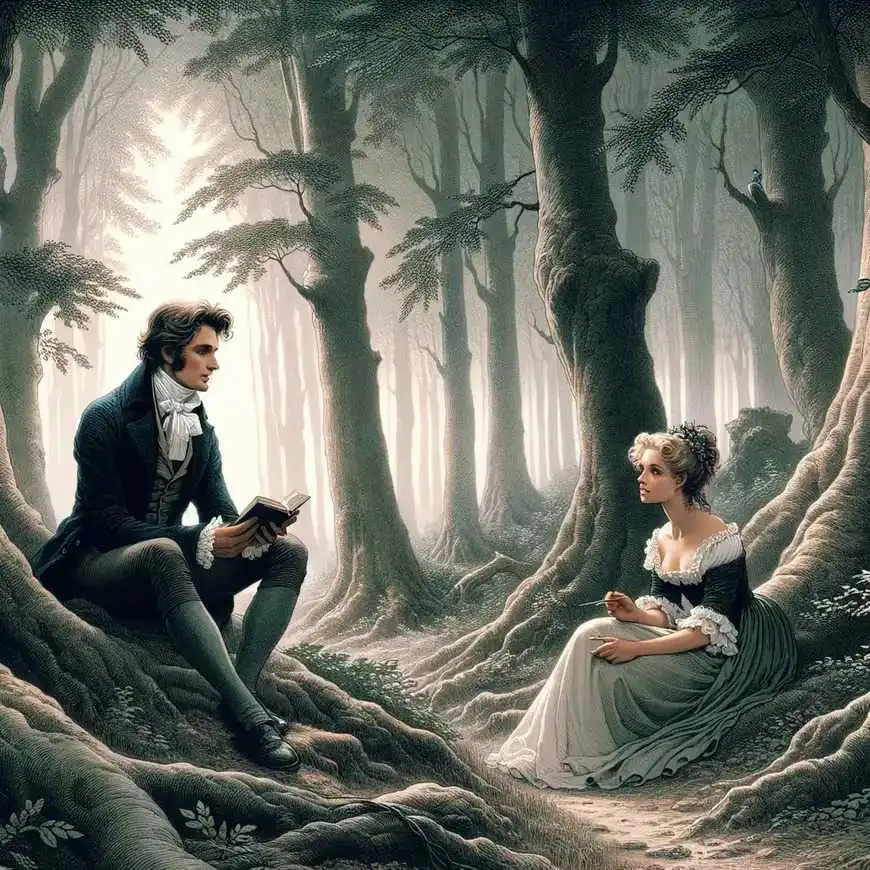Unveiling the Multifaceted Brilliance of Christa Wolf’s “No Place on Earth”: The Journey of Female Genius
Christa Wolf, one of the most prominent figures in German literature, presents a remarkable exploration of female genius in her novel “No Place on Earth” (Kein Ort. Nirgends). Published in 1979, this captivating work delves into the life of 18th-century German author Karoline von Günderrode, unearthing the complexities of her genius and the societal limitations placed upon her. With its poetic prose, introspective musings, and poignant historical context, “No Place on Earth” showcases Wolf’s mastery of storytelling and her unwavering commitment to highlighting the struggles and triumphs of women throughout history.
Unraveling the Life of Karoline von Günderrode
“No Place on Earth” takes readers on an introspective journey through the life of Karoline von Günderrode, an enigmatic figure of German Romanticism. Wolf carefully reconstructs Günderrode’s life, drawing upon historical sources and her own imaginative prowess to create a vivid portrayal of the challenges and aspirations that shaped the young poetess. Through her poignant and introspective narrative, Wolf invites readers to witness Günderrode’s pursuit of intellectual and artistic fulfillment amidst the constraints of societal expectations.

The Exploration of Female Genius and Creativity
At the heart of “No Place on Earth” lies the exploration of female genius and the unique struggles faced by women in the pursuit of their creative aspirations. Wolf delves into the multifaceted layers of Günderrode’s genius, examining the tension between societal expectations and her inner desires. The novel’s introspective narrative delves into the complexities of artistic expression and the sacrifices that women throughout history have had to make to cultivate their creativity.
Wolf contextualizes Günderrode’s life within the broader historical and cultural landscape of 18th-century Germany. Through meticulous research, she unveils the societal limitations and gendered expectations that hindered women’s intellectual and artistic pursuits during this time. Wolf exposes the challenges faced by Günderrode and other female geniuses, shedding light on the erasure and marginalization they experienced, while also celebrating their resilience and intellectual contributions.
Language and Identity
Wolf’s masterful use of language in “No Place on Earth” adds depth and nuance to the narrative. Through poetic prose and rich symbolism, she captures the essence of Günderrode’s struggles and aspirations, offering readers a profound insight into the inner workings of the protagonist’s mind. Wolf’s lyrical and introspective language highlights the power of words in shaping identity and serves as a testament to the significance of storytelling in the quest for self-discovery.
“No Place on Earth” is interwoven with literary allusions and references, showcasing Wolf’s engagement with literary history and her dialogue with other literary figures. From Johann Wolfgang von Goethe to Friedrich Hölderlin, Wolf engages in a profound conversation with the intellectual and literary luminaries of the time. These intertextual elements deepen the narrative layers, adding richness and complexity to the exploration of Günderrode’s genius.
Themes and elements of “No Place on Earth” by Christa Wolf
- The Search for Identity: Wolf’s characters often grapple with their place in society and their own internal conflicts. A quote reflecting this might discuss the characters’ feelings of alienation or their quest for self-understanding, illustrating Wolf’s interest in how personal and historical circumstances shape identity.
- The Role of Women in Society: Much of Wolf’s work critiques the roles available to women in her contemporary society and historically. A relevant quote might explore the constraints placed on the novel’s female characters or their desires to transcend societal expectations.
- The Nature of Time and Memory: Wolf frequently explores how individuals are haunted by their pasts and how memory shapes understanding of self and world. A quote on this theme might reflect on the characters’ reflections on their past experiences or their attempts to reconcile with their memories.
- The Intersection of the Personal and Political: Given Wolf’s context in East Germany and her engagement with socialist ideals, a significant quote might delve into the characters’ discussions of their political ideals and disappointments, showing the interplay between their personal beliefs and the broader political landscape.
- Artistic Creation as Resistance: The novel’s focus on two literary figures suggests an interest in the act of creation as a form of resistance or survival. A quote might highlight the characters’ views on poetry or art as a means to assert their individuality or to challenge oppressive structures.

Trivia Facts about “No Place on Earth”
- Based on Historical Figures: The novel imagines a meeting between the Romantic writer Karoline von Günderrode and the poet Heinrich von Kleist, both of whom were real historical figures. Neither ever met in real life, but Wolf uses this fictional encounter to explore themes of existential angst, artistic integrity, and societal constraints.
- Themes of Existential Despair: Both Günderrode and Kleist, in their real lives, were known for their struggles with societal norms and personal despair, which ultimately led to their suicides. Wolf’s narrative delves into these aspects, offering a speculative conversation that might have occurred had these two troubled souls met.
- Christa Wolf’s Signature Style: The book showcases Wolf’s characteristic blend of deep psychological insight, historical reflection, and feminist critique. Wolf is known for her explorations of how individual psyches and identities are shaped by societal and historical forces.
- A Reflection on GDR Politics: Though the novel is set in the early 19th century, its publication in 1981 came at a time when Wolf was increasingly scrutinized by the East German government. Her work, including “No Place on Earth,” can be read as a subtle critique of the repressive aspects of East Germany’s socialist regime, particularly in terms of intellectual and artistic freedom.
- Critical Acclaim and Controversy: Christa Wolf was one of East Germany’s most celebrated writers, and “No Place on Earth” was well-received for its innovative narrative technique and philosophical depth. However, Wolf’s works, including this novel, have also been at the center of debates regarding the role of intellectuals in socialist states and the ethical responsibilities of artists.
- Innovative Narrative Structure: The novel is notable for its non-linear structure and its blending of genres—part historical fiction, part philosophical dialogue, and part psychological exploration. This approach reflects Wolf’s interest in challenging traditional narrative forms to better capture the complexities of human consciousness and society.
- Part of a Larger Body of Work Exploring Female Subjectivity: “No Place on Earth” fits within Wolf’s broader literary project of reimagining the lives of historical women, giving voice to their experiences and struggles. Her work often centers on women who push against the boundaries of their historical contexts, making her one of the foremost feminist writers of her time.
- Influence on German Literature: Wolf’s novel contributes to a rich tradition of German literature that interrogates the nation’s history, culture, and psyche. Her work is part of a lineage that includes Thomas Mann, Bertolt Brecht, and Günter Grass, among others, who have used fiction to explore deep social and existential questions.
- Translation and International Reception: Like much of Wolf’s work, “No Place on Earth” has been translated into several languages, introducing her complex exploration of historical and existential themes to a global audience. The novel’s reception outside Germany reflects the universal relevance of its themes and the international interest in Wolf’s unique literary voice.
- Legacy of Christa Wolf: Christa Wolf remains a towering figure in German literature, and “No Place on Earth” is a testament to her skill in blending historical insight with literary innovation. Her work continues to inspire discussions about the role of the artist in society, the nature of individual and collective memory, and the possibilities of literary form.
Legacy and Impact of “No Place on Earth”
“No Place on Earth” has left an indelible mark on the literary landscape, solidifying Christa Wolf’s reputation as one of the most significant voices in German literature. The novel’s unflinching exploration of female genius, its profound historical context, and its lyrical prose continue to resonate with readers. “No Place on Earth” stands as a testament to the power of storytelling to shed light on forgotten voices and to illuminate the struggles and triumphs of women throughout history.
Conclusion No Place on Earth: Unveiling the Multifaceted Brilliance
Christa Wolf’s “No Place on Earth” is a testament to the enduring power of female genius and the indomitable spirit of women navigating societal limitations. Through her meticulous reconstruction of Karoline von Günderrode’s life, Wolf invites readers to witness the complexities of female creativity, the challenges faced by women in pursuing their artistic aspirations, and the profound impact of their contributions. “No Place on Earth” shines a light on the journey of female genius, reminding us of the resilience and tenacity of women throughout history. Wolf’s poignant storytelling and profound exploration of identity make “No Place on Earth” a literary masterpiece that continues to captivate and inspire readers.